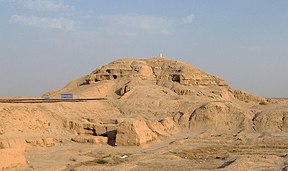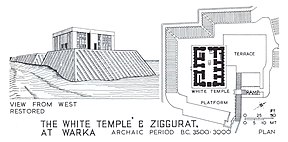A ziggurat (/ˈzɪɡʊˌræt/; Cuneiform: 𒅆𒂍𒉪, Akkadian: ziqqurratum,[2] D-stem of zaqārum 'to protrude, to build high',[3] cognate with other Semitic languages like Hebrew zaqar (זָקַר) 'protrude'[4][5]) is a type of massive structure built in ancient Mesopotamia. It has the form of a terraced compound of successively receding stories or levels. Notable ziggurats include the Great Ziggurat of Ur near Nasiriyah, the Ziggurat of Aqar Quf near Baghdad, the no longer extant Etemenanki in Babylon, Chogha Zanbil in Khūzestān and Sialk. The Sumerians believed that the gods lived in the temple at the top of the ziggurats, so only priests and other highly-respected individuals could enter. Sumerian society offered these individuals such gifts as music, harvested produce, and the creation of devotional statues to entice them to live in the temple.
- ^ Crüsemann, Nicola; Ess, Margarete van; Hilgert, Markus; Salje, Beate; Potts, Timothy (2019). Uruk: First City of the Ancient World. Getty Publications. p. 325. ISBN 978-1-60606-444-3.
- ^ "Search Entry". www.assyrianlanguages.org. Retrieved 2020-07-30.
- ^ "Search Entry". www.assyrianlanguages.org. Retrieved 2020-07-30.
- ^ "מילון מורפיקס | זקר באנגלית | פירוש זקר בעברית". www.morfix.co.il. Retrieved 2020-07-30.
- ^ see also Akkadian zaqru 'protruding, high', corresponding to Hebrew zaqur (זָקוּר) 'protruding out, upwards'

